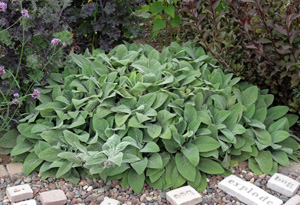
Lamb’s ears (Stachys byzantina) is a favorite addition to Midwest gardens for the silver color and irresistible soft, fuzzy velvety feel of the leaves. This creeping herbaceous perennial native to the Middle East and hardy in zones 4-9 is cultivated throughout much of the temperate world as an ornamental for its unique texture and color. There is one cultivar with much larger leaves that is offered under the names ‘Big Ears’, ‘Countess Helen von Stein’ or ‘Helene von Stein’.
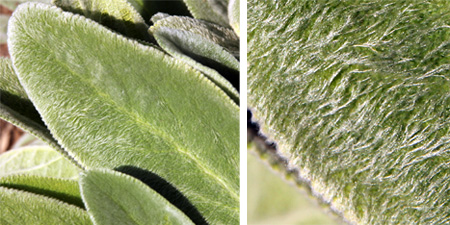
This vigorous cultivar of Stachys forms a low mound (6-12 inches tall) of dense, rosettes with more of a grey-green cast than the bright silvery-white appearance of the species. The huge leaves grow up to a foot long (twice as big as the species) and are thickly covered on both sides with long, white, silky-lanate hairs, giving them the characteristic silver-grey color.
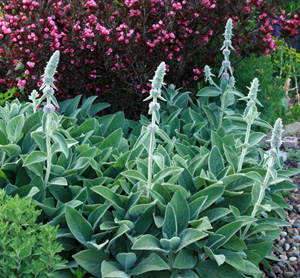
The undersides are usually lighter in color than the upper surface, which may appear greenish when wet. Each wide, lance-shaped leaf gradually narrows to a rounded point. It is evergreen in areas with mild winters but dies back almost to the ground in cold areas. The stems will root where they contact the soil, allowing the plant to spread.
Insignificant purple flowers appear in sporadic furry flower spikes held erect above the foliage in late spring or early summer.

The 4-sided flowering spikes have many flowers in verticillasters (a cymose inflorescence resembling a whorl but actually arising in the axils of opposite bracts) crowded together over most of the length of the stem along with a few greatly reduced leaves. The tiny, two-lipped tubular flowers are mostly hidden by the hairs on the stem. If pollinated, flowers may be followed by oblong, hairless, brown nutlets. Most people prefer to remove any flower spikes that would spoil the effect as a silver carpet but since this cultivar doesn’t bloom much, there is little time spent deadheading.
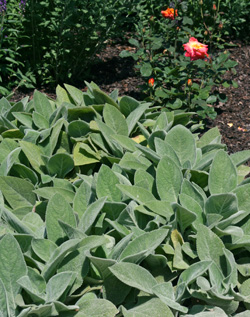
Use ‘Big Ears’ as a groundcover, for edging, or spilling out along a path to soften the edges of hard, straight lines. It can also be used in larger mixed containers or in a sensory garden for people to touch the wooly leaves. It combines well with roses, iris, catmint (Nepeta) and sedums, and as a bold contrast to many other herbaceous perennials in a cottage garden. It can be used in an herb garden, mixed in with herbs that have low water needs, such as lavender, sage, and thyme. It is one of the best perennials with silver foliage to create a Mediterranean feel in Midwestern gardens (where many other silver-leaved plants do not thrive). It makes a wonderful addition to a sunny rock garden and “Moon” or “White” gardens. The silver foliage looks great massed in the front of the border with purple flowers or as an accent plant against dark green or purple foliage.
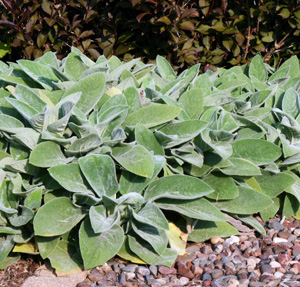
The silvery color serves as a foil for boldly-colored flowers that otherwise could be too intense. Foliage can also be cut to use in fresh or dried arrangements.
As with most lamb’s ears, ‘Big Ears’ is a relatively low maintenance plant. It prefers full sun and well-drained soils. But it is quite adaptable, doing well in light shade and all types of soil, including heavy clay. It tolerates heat and moderate humidity, is drought tolerant once established, and is not bothered by deer. It has no significant pests, other than root and crown rots if grown in wet soil. Although they will spread they are not invasive and are easily removed by hand or digging the shallow-rooted sections.
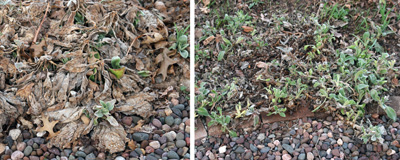
Dead foliage should be removed in spring to tidy the appearance of the clumps but otherwise the plants don’t require much care. They look best in lean soils, so should not be fertilized. Clumps can be divided in spring or fall by removing rooted sections. Plants should be divided to rejuvenate every 4-5 years or when the centers die out. The plant will wilt and look pathetic until they are re-established.
– Susan Mahr, University of Wisconsin – Madison
Ask Your Gardening Question
If you’re unable to find the information you need, please submit your gardening question here:





 ▶︎ Watch: Fall Bulb Planting
▶︎ Watch: Fall Bulb Planting Aster, Symphyotrichum spp.
Aster, Symphyotrichum spp. Fascinating Fasciation
Fascinating Fasciation Alternatives to Lawn: Groundcovers
Alternatives to Lawn: Groundcovers


